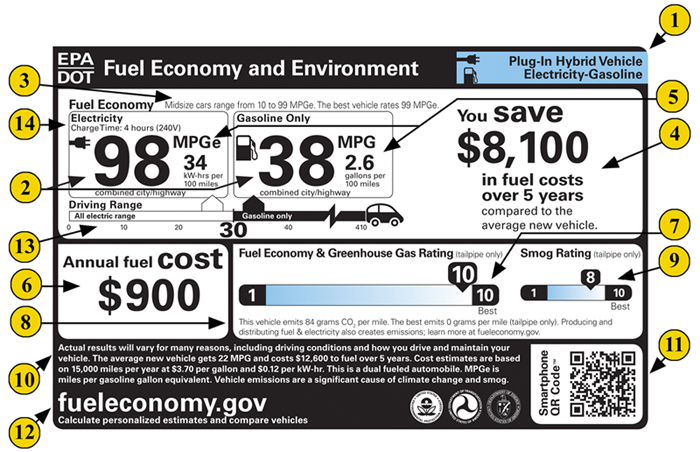Interactive Version of the Plug-in Hybrid Electric Vehicle Label
Read a text description of the label
Move your mouse over the numbers to see details.

1. Vehicle Technology & Fuel
Shows the type of fuel or fuels the vehicle can use. You will most commonly see "Gasoline Vehicle," "Flexible Fuel Vehicle: Gasoline-Ethanol," or "Diesel Vehicle."
More about Vehicle Technology & Fuel
2. Fuel Economy
Fuel efficiency for combined city and highway driving is shown for both modes of operation: on electricity and on gasoline. Electric fuel efficiency is shown in miles per gallon equivalent (MPGe). MPGe is a metric based on energy content that can be used to compare across different vehicle technologies and fuels.
More about Fuel Economy
3. Comparing Fuel Economy to Other Vehicles
Look here to compare the fuel efficiency of this vehicle to other vehicles in the same category and to find out the highest fuel economy among all vehicles.
More about Comparing Fuel Economy to Other Vehicles
4. You Save
This is an estimate of how much more (or less) this vehicle will cost to fuel over five years relative to the average new vehicle, based on the assumptions listed in the print at the bottom of the label.
More about You Save/Spend More over 5 Years Compared to Average Vehicle
5. Fuel Consumption Rate
The estimated rate of fuel consumption for combined city and highway driving. Electricity consumption is shown in kilowatt-hours per 100 miles and gasoline consumption is shown in gallons per 100 miles. Unlike MPG, consumption relates directly to the amount of fuel used, and thus to fuel expenditures.
More about Fuel Consumption Rate
6. Estimated Annual Fuel Cost
The estimated annual fuel cost of the vehicle, based on the assumptions listed in the print at the bottom of the label.
More about Estimated Annual Fuel Cost
7. Fuel Economy and Greenhouse Gas Rating
A 1 to 10 rating based on fuel economy and greenhouse gas emissions, where a rating of 10 is best. The pointer shows where this vehicle is within the range.
More about Fuel Economy and Greenhouse Gas Rating
8. CO2 Emissions Information
Shows tailpipe CO2 emissions in grams per mile for combined city and highway driving and the emissions of the vehicle with the lowest CO2 emissions. Explains that consumers can learn more about emissions from the production of fuels at www.fueleconomy.Gov.
More about CO2 Emissions Information
9. Smog Rating
A 1 to 10 rating, where a rating of 10 is best, based on exhaust emissions that contribute to air pollution. The pointer shows where this vehicle is within the range.
More about Smog Rating
10. Details in Fine Print
Look here for information related to the estimates and ratings, such as the assumptions used to determine the estimated annual fuel cost (15,000 miles per year, $0.12 per kilowatt-hour, and $3.70 per gallon for this example). Also contains a reminder that "your mileage will vary."
More about Details in Fine Print
11. A QR Code®
Download a free bar code app to your smartphone and scan this QR Code® to get additional and customizable information about the vehicle.
More about QR Code
12. www.fueleconomy.gov
Consumer information and tools associated with the new labels will be available at: www.fueleconomy.gov
More about www.fueleconomy.gov
13. Driving Range
Shows the estimated all-electric range on a fully charged battery and the estimated total range using both gasoline and electricity.
More about www.fueleconomy.gov
14. Charge Time
This indicates how long it takes to charge a fully empty battery using 240 volt electrical service.
More about www.fueleconomy.gov
